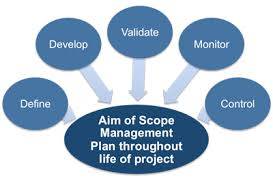Scope Management
Term Definitions of Scope Management Scope Management helps avoid challenged projects with every growing scope and unruly requirements list. Project scope defines what is or is not included in the project, and controls what gets added or removed as the project is executed. Scope management establishes control processes to address factors that may result in […]
Term Definitions of Scope Management
Scope Management helps avoid challenged projects with every growing scope and unruly requirements list. Project scope defines what is or is not included in the project, and controls what gets added or removed as the project is executed. Scope management establishes control processes to address factors that may result in project change during the project life-cycle.
Project changes that impact scope management include:
-Requirements: the ultimate objectives of the project
-Constraints: limitations such as time, budget, resource dependency, business, legal, organizational, technological and management constraints
-Assumptions: statements that are considered facts for planning purposes but require verification; for example, a software project may assume a new system will not require a full-time database administrator after implementation is complete
-Risks: any business or technical factor that has reasonable potential to impact the project (or its assumptions); key risk characteristics include: probability of occurrence, impact, mitigating action, and contingent action
-Project scope management is commonly broken down into five separate processes: project approval, scope planning, scope definition, scope verification, and scope change control. Each of these processes is briefly described in the following discussion and illustrated in the figure below.
 Scope Management Challenges
Scope Management Challenges
Scope management for projects is an essential activity for professional services organizations. When it is not performed effectively, the consequences of scope creep for customers and providers are significant. The outcome of poor scope management can result in the following challenges:
-Unsatisfied customers resulting in poor satisfaction scores when you are not able to meet on commitments
-Important project deadlines are missed
-Ability to meet Timelines and project quality suffers
-Resource motivation drops
-Project Costs increase and savings targets are not met
Effective project management and professional services automation software facilitates organizations to better manage scope by delivering good communication, planning and reporting tools to ensure that everyone on the team understands the scope of the project and agrees upon exactly how the project’s goals will be met. Typically as a part of a larger project management solution, scope management software aligns the project team leader with the various stakeholders as the project proceeds, ensuring that the finished project, as proposed, meets everyone’s needs. Here are some of the most common features provided by these systems to facilitate the scope management, project scope and scope creep:
-Project planning and scheduling
-Scope change request
-Project Collaboration
-Process management workflows
-Dashboard and reporting
When evaluating its features, it is critical to effectively review the multitude of solutions in the marketplace to ensure their in line with your scope management needs.
